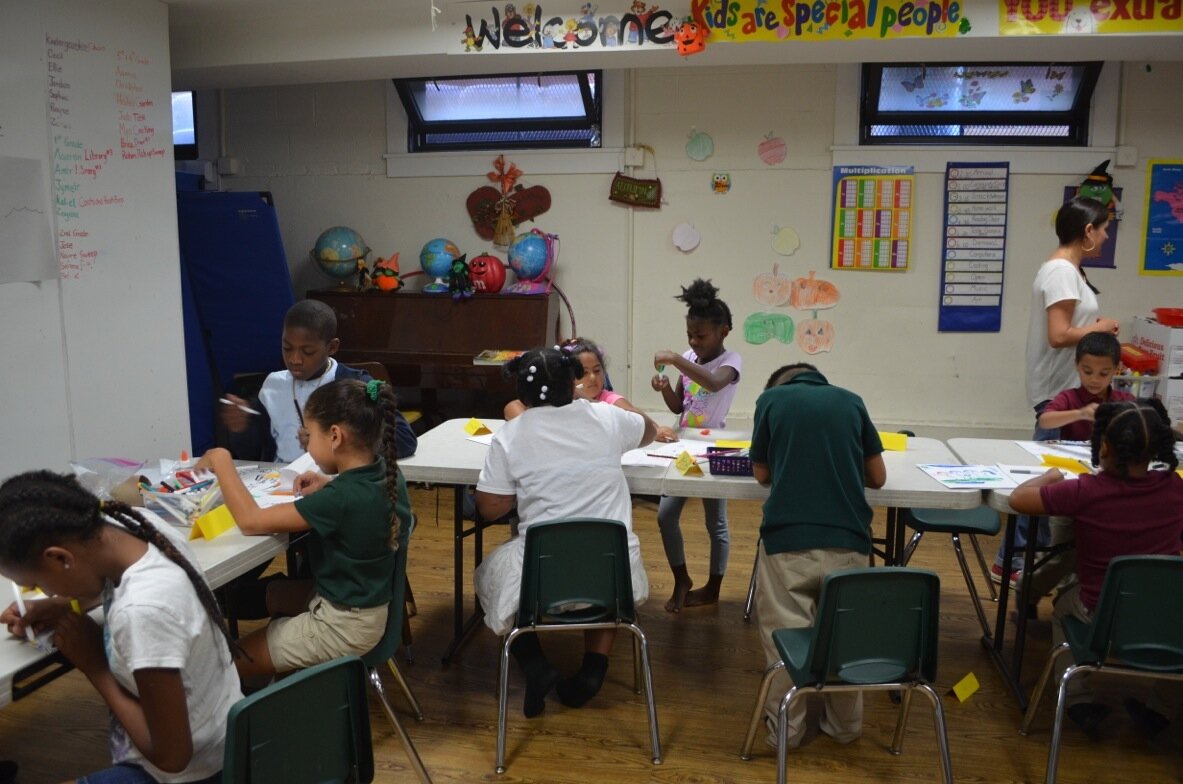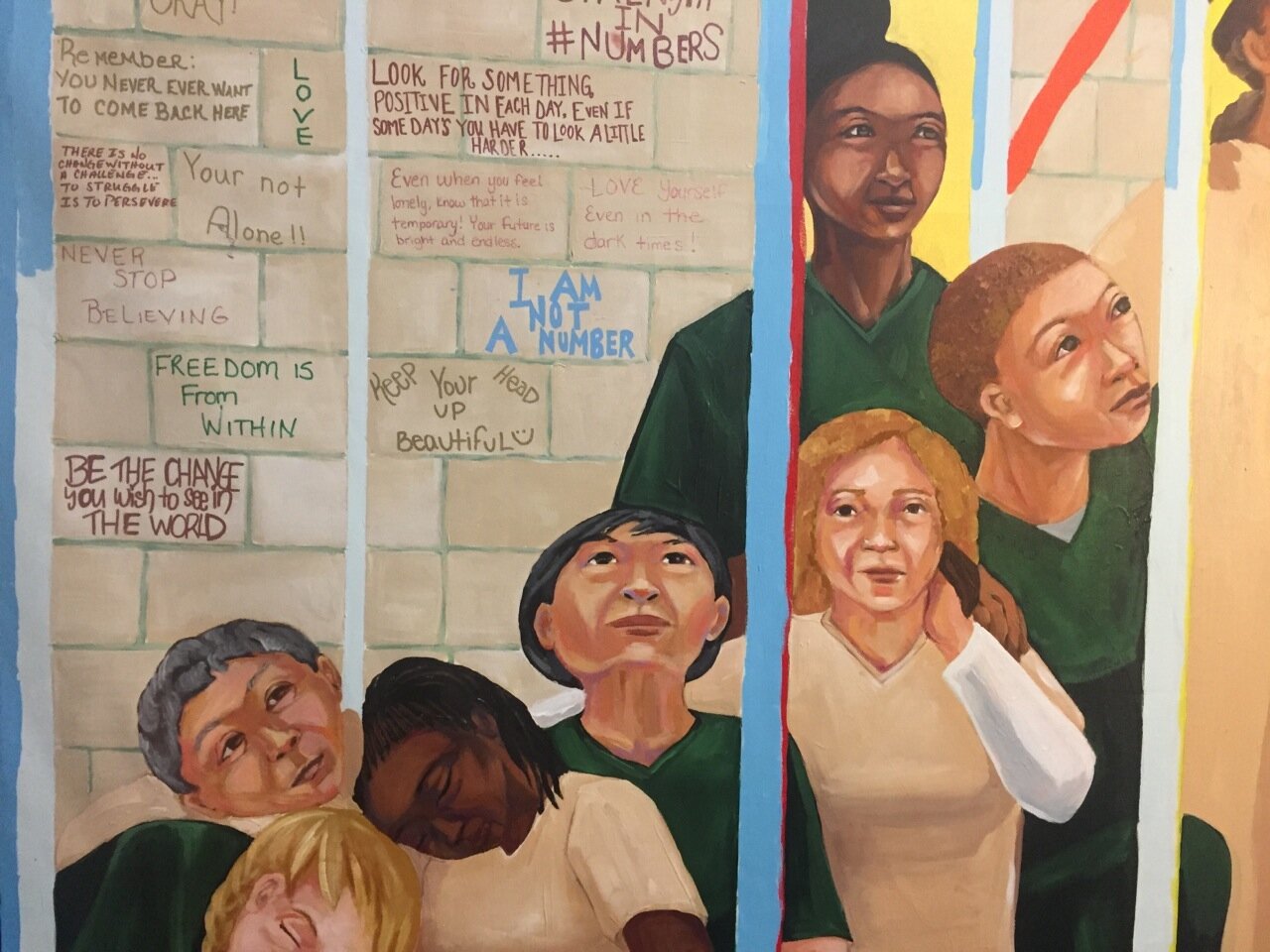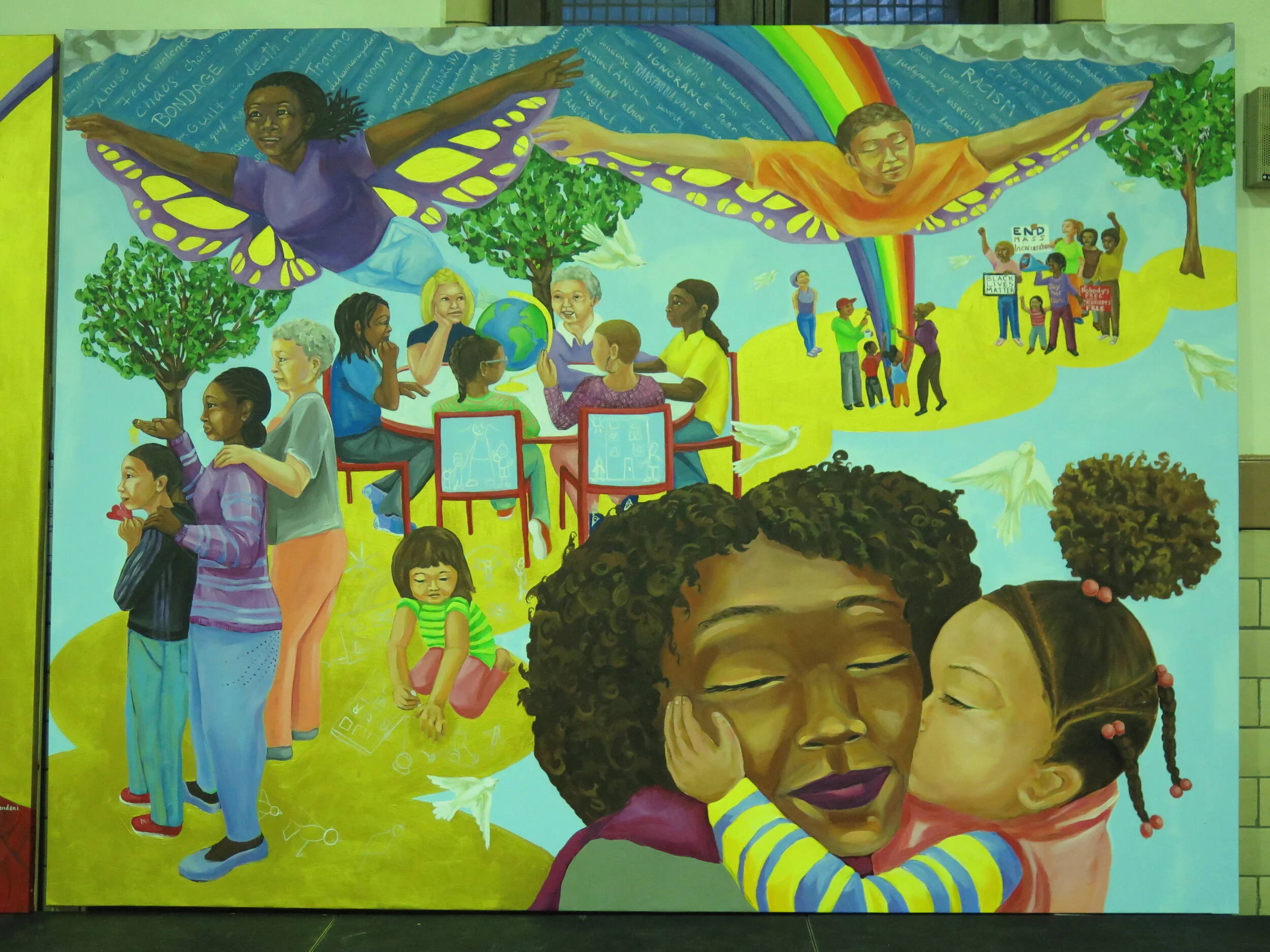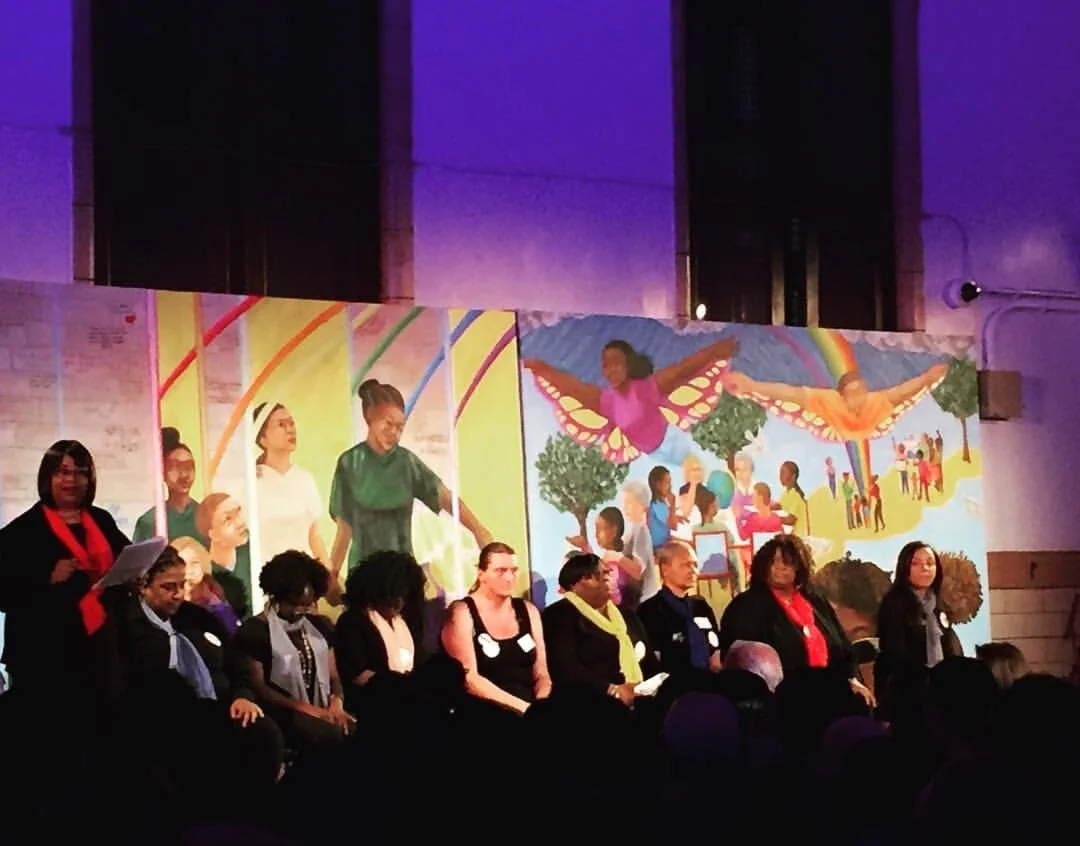Transformation from the Inside Out
Transformation from the Inside Out was a gift of a project for me to be involved in this year. The Women and Justice Project, an incredible organization devoted to the end of mass incarceration of women, hired me to work with formerly incarcerated women both from “The Working Group,” an incredible group of 20+ women who are advocates, activists, leaders in the movement; and with “Hour Children,” an organization out in Long Island City, Queens, that provides housing, counseling, addiction services, job training, parenting programs, educational resources, etc. for formerly incarcerated women and their children.
I conducted workshops with the women and kids, exploring the idea of “transformation.” The transformation we were discussing was both personal and societal, and included a very special element related to the closing of Bayview Correctional Facility, a former medium-security women’s prison in Chelsea, Manhattan. After Hurricane Sandy, the prison was closed and the NOVO Foundation won a 99 year lease on the building from the State of New York. They have committed to creating “The Women’s Building,” a global hub for women’s and girls’ movements. The mural was conceived of in an effort to help visualize what transformation looks like for this community of women, and how The Women’s Building can aspire to best serve the formerly incarcerated and their families as we all work to build a more just society.




After our brainstorming and design workshops, I used all the writings, drawings and discussion material to form the design and then took it back to the group for approval. Then we got to painting . . .









When the painting was done, I cleaned things up at my studio (I think our youngest painter was 18 months, so you understand!), and prepared for the big event.




On January 14, The Women’s Building opened for a sold-out event prior to it’s complete renovation which is charted to take the next 3 years. There were speakers, theatrical performances performed by women telling their own stories, musical performances, a “Say Her Name” memorial portion where the names of women lost to state-sanctioned violence on both the inside and outside were read aloud and so much more. It was the greatest event I’ve had the opportunity to participate in as a muralist. I’ve never been in a room where there was so much truth, so much generosity, so much pain and so much support. It makes me feel so optimistic for the future of that building and the future of the movement to end mass incarceration.
Below is the entire description of both panels of the mural. After the event, it was put into storage and will hopefully be prominently displayed at The Women’s Building when its renovation is complete in 2020!


Summary:
In keeping with the theme of the inaugural event at the soon-to-be Women’s Building, the theme of this mural is transformation. The mural would be painted collectively with the Hour Children community on two 8’ x 10’ canvas panels and then retouched prior to their display on October 29. I worked with the women from the Working Group as well as many women, children and staff at Hour Children to develop imagery and concepts for the mural. During the workshops and meetings, many themes came up through writings, discussion and art activities. They are reflected in the mural design in the following ways:
Left Panel:
The left panel shows group of women, gathered and huddled around a fallen women. They are comforting, embracing, supporting, grieving, angering, thinking and looking forward. The fallen woman represents Sandra Bland, as requested by many women in the workshops. She also represents the many other women lost both on the inside and out in state-sanctioned violence.
The young woman in the background represents Bresha Meadows, and the plight of incarcerated adolescents around the world. She also symbolizes the unfortunate truth of how the state prosecutes domestic violence. The women are on a hill of sorts, made of cocoons and chains. The cocoons represent a guarded, protected moment early in transformation. The lower left postures of the women also represent this cocoon-like state. The chains represent not only the negative, of being locked away, but also the bond and sisterhood created during incarceration. As the women move from bottom to top, left to right, the women gain strength from their bonds with one another and their postures begin to lift and open. Some women look to the right at the figures in the second panel, women who are continuing to offer their support from the outside. Ultimately, the figure on the right, lifts her arm and realized she has grown a wing.
Woven in and out of the design are vertical bars, symbolizing incarceration. The bars are intended to illuminate, to shed light on the bars that many incarcerated women were born into that exists far beyond prison walls: poverty, abuse, addiction, neglect, etc. On the right side, the bars begin to branch off and form a rainbow which carries over to the right panel. The theme of illumination combined with lightness is also carried through in the butterfly wings on both sides. Participants talked about wanting to be transparent and light in their lives, living freely and honestly, letting hard or painful things kind of flow through them, rather than get stuck on the inside. The lightness of the wings is intended to represent that.
Golden panels in the background symbolize the sacred, precious nature of every life on the inside. Gold is also used in Japanese screens to illuminate a dark space, which is also relevant here. The white panels will be painted to represent cell walls and women who participate in the painting process will have the opportunity to write “on the wall” a message to themselves when they were on the inside.
The left panel is intended to show the depth of hardship that the women have experienced, while showing how the bonds created on the inside not only helped to make them more resilient, but also helped better prepare them for life on the outside. Other symbols on the chests of some figures show important factors that further enhanced each woman’s strength and survival. Specifically: that the commitments their families showed to them while on the inside, their contact with their children, their investment to their own education, their struggle to overcome addiction and their willingness to write out and creatively express their feelings.
Right Panel
The right panel shows the continued transformation after the period of incarceration. In the foreground, a large, loving image of mother and child shows one primary motivation many women expressed in maintaining their focus and improving their lives.
To the left of them, a group of three, representing 3 generations, reach back to the women in the left panel, to the women still incarcerated. They are there to offer them love and support. The woman in the center of that section extends her hand with a key, which could symbolize a key to housing, to the future, to her education, etc. The main point of that section is that once released, the women undergoing their post- incarceration life do not forget the women on the inside.
Behind them, a group of women sit around a table. They could be at a job training, in a classroom discussion, in a support group, etc. They represent collective growth- when one does better and is generous with their experience, we all do better.
Behind them to the right, a group from the community finishes painting the rainbow that started its arc in the prison, in the left panel. They represent the transforming relationship women have either with their old communities or with their new communities. The idea is that the community is there to best support the woman in her transformation in any way possible. Included in this section, would be the concept of the Women’s Building as a community resource.
The protest scene celebrates the change-making power women alone possess when it comes to creating and sustaining movements. The giant themes of the movement are represented in their sign and shirts . . . SAY HER NAME, END MASS INCARCERATION, BLACK LIVES MATTER, and Fannie Lou Hammer’s quote that NOBODY’S FREE UNTIL EVERYONE’S FREE.
These scenes all take place on top of interlocking circles that mimic the chains. The idea here is that by breaking chains that used to bind, new pathways can be created that can be used to positively bond and progress.
Above this scene, there are two women in flight. They are free, empowered and strong. They are survivors who have transformed the depths of their struggle into the strength of their resolve to live freely. They also are protectors, helping those recently released and struggling. They are protecting their peers from stormy times, supporting them through their anxiety and helping them get on the right path as well. The two women in flight protect not only the families who are rebuilding below, but also the women from the first panel who are preparing for new life on the outside. They are protecting them from the storm that brews above their wings, the forces that lead to mass incarceration. Abuse, poverty, homophobia, transphobia, addiction, etc.
Trees begin to blossom throughout this image, reflecting the vertical motif from the left panel, but in this case symbolizing strength, growth and continued transformation. Tucked into one of the trees is a small cat, a symbol requested by the participants to honor Sister Tesa’s loving, tireless work at Hour Children.






